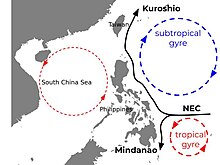This article needs additional citations for verification. (May 2021) |
The Kuroshio Current is a northward flowing Western Boundary Current (WBC) in the Pacific Ocean. It is a bifurcation arm of the North Equatorial Current and consists of northwestern Pacific Ocean water. The other arm is the southward flowing Mindanao Current. The Kuroshio Current flows along the eastern Philippine coast, up to 13.7 Sv...[1] of it leaking into the Luzon Strait - the gap between the Philippines and Taiwan - before continuing along the Japanese coast. Some of the leaked water manages to intrude into the South China Sea (SCS). This affects the heat and salt budgets and circulation and eddy generation mechanisms in the SCS.[2] There are various theories about possible intrusion paths and what mechanisms initiate them.[3]

- ^ Chu, P. C.; Li, R. F. (2000). "South China Sea Isopycnal-Surface Circulation". Journal of Physical Oceanography. 30 (2419): 2419. Bibcode:2000JPO....30.2419C. doi:10.1175/1520-0485(2000)030<2419:SCSISC>2.0.CO;2.
- ^ Qu, T.; Y. Y., Kim (2004). "Can Luzon Strait Transport Play a Role in Conveying the Impact of ENSO to the South China Sea?". Journal of Climate. 17 (3644): 3644. Bibcode:2004JCli...17.3644Q. doi:10.1175/1520-0442(2004)017<3644:CLSTPA>2.0.CO;2.
- ^ Nan, F.; Xue, H. (2015). "Kurishio Intrusion into the South China Sea: A Review". Progress in Oceanograohy. 137 (314).